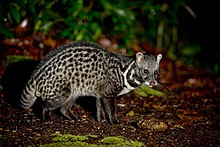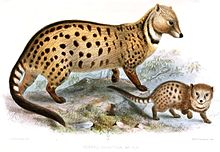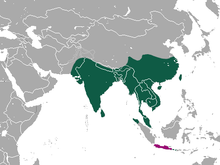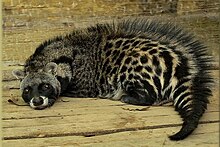| Viverrinae Temporal range: Miocene–Present PreꞒ Ꞓ O S D C P T J K Pg N | |
|---|---|

| |
| African civet (Civettictis civetta) | |
| Scientific classification | |
| Domain: | Eukaryota |
| Kingdom: | Animalia |
| Phylum: | Chordata |
| Class: | Mammalia |
| Order: | Carnivora |
| Suborder: | Feliformia |
| Family: | Viverridae |
| Subfamily: | Viverrinae Gray, 1864 |
| Genera | |
The Viverrinae represent the largest subfamily of the Viverridae comprising three genera, which are subdivided into six species native to Africa and Southeast Asia. This subfamily was denominated and first described by John Edward Gray in 1864.
Classification
Gray defined the Viverrinae as comprising the genera Proteles, Viverra, Bassaris and Viverricula. He subordinated the genera Genetta and Fossa to the Genettina, the genera Prionodon and Poiana to the Prionodontinae. Reginald Innes Pocock suggested that the African genets (Genetta) are also most nearly related to the Viverrinae, but should perhaps form a separate subfamily. William King Gregory and Milo Hellman placed the Viverra, Viverricula, Civettictis, Genetta, Osbornictis, Poiana and the North-American eucreodine genera Didymictis and Viverravus of the Eocene into this viverrid subfamily. Ellerman and Morrison-Scott also included the genus Prionodon.
DNA analysis based on 29 Carnivora species comprising 13 Viverrinae species and three species representing Paradoxurus, Paguma and Hemigalinae supports the placement of Prionodon in the monogeneric family Prionodontidae as the sister-group of the Felidae. These investigations also clarified the controversial issue of the boundaries of this subfamily supporting the Viverrinae as being constituted by two monophyletic groups, namely the terrestrial civets Civettictis–Viverra–Viverricula and Poiana–Genetta.
At present, the Viverrinae comprise:
| Genus | Species | IUCN Red List status and distribution |
|---|---|---|
| Viverra Linnaeus, 1758 | Large Indian civet (V. zibetha) Linnaeus, 1758 
|
LC
|
Malayan civet (V. tangalunga) Gray, 1832
|
LC
| |
| Malabar large-spotted civet (V. civettina) Blyth, 1862 | CR
| |
Large-spotted civet (V. megaspila) Blyth, 1862
|
EN
| |
| Viverricula Hodgson, 1838 | Small Indian civet (V. indica) Étienne Geoffroy Saint-Hilaire, 1803
|
LC
|
| Civettictis Pocock, 1915 | African civet (C. civetta) (Schreber, 1776)
|
LC
|
Characteristics
Viverrina species have a robust body. There is a deep pouch for secreting in the form of a deep cavity on each side of the anus. The back of the hind feet is hairy except the pad of the toes and the metatarsus. The digitigrade feet are adapted for movement on the ground. The cushion-like indistinctly subdivided plantar pad and the pads of digits 2 to 4 are alone applied to the ground. The first digit is small and set well above the plantar pad, and constitutes a practically functionless "dew-claw". The dental formula is: 3.1.4.23.1.4.2.
The outstanding characteristics of the modern Viverrinae are the high development of the perineal scent glands, the marked anteroposterior elongation of the entotympanic chamber of the compound bulla and the carnassial form of the cheek-teeth.
They have excellent hearing and vision. Their flesh-shearing carnassial teeth are relatively undeveloped.
Viverrids are amongst the primitive families of the Carnivora, with skeletons very similar to those of fossils dating back to the Eocene, up to 50 million years ago. They are variable in form, but generally resemble long-nosed cats. Most have retractile or partially retractile claws, and a baculum.
The Viverrinae range in size from the African linsang with a body length of 33 cm (13 in) and a weight of 650 g (1.43 lb) to the African civet at 84 cm (33 in) and 18 kg (40 lb).
Distribution and ecology
This subfamily is found throughout the Oriental region, and is represented in Africa by the African civet (Civettictis civetta). The common genet (Genetta genetta) is considered to have been introduced to Europe and the Balearic islands, and occurs in all of continental Portugal, Spain and most of France.
They are generally solitary and omnivorous, despite their placement in the order Carnivora.
References
- "Viverrinae". Paleobiology Database.
- Wozencraft, W. C. (2005). "Order Carnivora". In Wilson, D. E.; Reeder, D. M. (eds.). Mammal Species of the World: A Taxonomic and Geographic Reference (3rd ed.). Johns Hopkins University Press. pp. 548–559. ISBN 978-0-8018-8221-0. OCLC 62265494.
- ^ Gray, J. E. (1864). "A revision of the genera and species of viverrine animals (Viverridae), founded on the collection in the British Museum". Proceedings of the Zoological Society of London for the Year 1864: 502–579.
- ^ Pocock, R. I. (1939). "Subfamily Viverrinae". The Fauna of British India, including Ceylon and Burma. Vol. Mammalia. – Volume 1. London: Taylor and Francis. pp. 342–376.
- ^ Gregory, W. K. & Hellman, M. (1939). "On the evolution and major classification of the civets (Viverridae) and allied fossil and recent Carnivora: Phylogenetic study of the skull and dentition". Proceedings of the American Philosophical Society. 81 (3): 309–392. ISBN 9781422372258.
- Ellerman, J. R. & Morrison-Scott, T. C. S. (1966). "Genus Prionodon Horsfield 1822". Checklist of Palaearctic and Indian mammals 1758 to 1946 (Second ed.). London: British Museum of Natural History. pp. 284–285.
- Gaubert, P. & Veron, G. (2003). "Exhaustive sample set among Viverridae reveals the sister-group of felids: the linsangs as a case of extreme morphological convergence within Feliformia" (PDF). Proceedings of the Royal Society. Series B, 270 (1532): 2523–2530. doi:10.1098/rspb.2003.2521. PMC 1691530. PMID 14667345.
- Gaubert, P. & Cordeiro-Estrela, P. (2006). "Phylogenetic systematics and tempo of evolution of the Viverrinae (Mammalia, Carnivora, Viverridae) within feliformians: implications for faunal exchanges between Asia and Africa" (PDF). Molecular Phylogenetics and Evolution. 41 (2): 266–278. Bibcode:2006MolPE..41..266G. doi:10.1016/j.ympev.2006.05.034. PMID 16837215.[REDACTED]
- Nyakatura, K. & Bininda-Emonds, O. R. P. (2012). "Updating the evolutionary history of Carnivora (Mammalia): a new species-level supertree complete with divergence time estimates". BMC Biology. 10: 12. doi:10.1186/1741-7007-10-12. PMC 3307490. PMID 22369503.
- ^ Linnæus, C. (1758). "Viverra Zibetha". Systema naturæ per regna tria naturæ, secundum classes, ordines, genera, species, cum characteribus, differentiis, synonymis, locis. Tomus I (in Latin) (10 ed.). Holmiæ (Stockholm): Laurentius Salvius. p. 44.
- Timmins, R.J.; Duckworth, J. W.; Chutipong, W.; Ghimirey, Y.; Willcox, D. H. A.; Rahman, H.; Long, B. & Choudhury, A. (2016). "Viverra zibetha". IUCN Red List of Threatened Species. 2016: e.T41709A45220429. doi:10.2305/IUCN.UK.2016-1.RLTS.T41709A45220429.en.
- Gray, J. E. (1832). "On the family of Viverridae and its generic sub-divisions, with an enumeration of the species of several new ones". Proceedings of the Committee of Science and Correspondence of the Zoological Society of London. 2: 63–68.
- Duckworth, J. W.; Mathai, J.; Wilting, A.; Holden, J.; Hearn, A. & Ross, J. (2016). "Viverra tangalunga". IUCN Red List of Threatened Species. 2016: e.T41708A45220284. doi:10.2305/IUCN.UK.2016-1.RLTS.T41708A45220284.en.
- ^ Blyth, E. (1862). "Report of curator, zoological department, February, 1862, No. 1". Journal of the Asiatic Society of Bengal (31): 331−333.
- Duckworth, J. W.; Mathai, J.; Wilting, A.; Holden, J.; Hearn, A. & Ross, J. (2016). "Viverra tangalunga". IUCN Red List of Threatened Species. 2016: e.T41708A45220284. doi:10.2305/IUCN.UK.2016-1.RLTS.T41708A45220284.en.
- Timmins, R.; Duckworth, J.W.; WWF-Malaysia; Roberton, S.; Gray, T.N.E.; Willcox, D. H. A.; Chutipong, W. & Long, B. (2016). "Viverra megaspila". IUCN Red List of Threatened Species. 2016: e.T41707A45220097. doi:10.2305/IUCN.UK.2016-1.RLTS.T41707A45220097.en.
- Hodgson, B. H. (1838). "Classified Catalogue of Nepalese Mammalia". Annals of Natural History. 1 (2): 152−154.
- Geoffroy Saint-Hilaire, E. (1803). "La Civette de l'Inde". Catalogue des Mammifères du Museum National d'Histoire Naturelle. Paris: Museum National d'Histoire Naturelle. p. 113.
- Choudhury, A.; Duckworth, J.W.; Timmins, R.; Chutipong, W.; Willcox, D.H.A.; Rahman, H.; Ghimirey, Y. & Mudappa, D. (2015). "Viverricula indica". IUCN Red List of Threatened Species. 2015: e.T41710A45220632. doi:10.2305/IUCN.UK.2015-4.RLTS.T41710A45220632.en.
- Pocock, R. I. (1915). "On the Feet and Glands and other External Characters of the Viverrinae, with the description of a New Genus". Proceedings of the Zoological Society of London. 85: 131−149. doi:10.1111/j.1469-7998.1915.00131.x.
- Schreber, J. C. D. (1778). "Die Civette Viverra civetta". Die Säugethiere in Abbildungen nach der Natur, mit Beschreibungen. Erlangen: Wolfgang Walther. pp. 418–420.
- Do Linh San, E.; Gaubert, P.; Wondmagegne, D. & Ray, J. (2015). "Civettictis civetta". IUCN Red List of Threatened Species. 2015: e.T41695A45218199. doi:10.2305/IUCN.UK.2015-4.RLTS.T41695A45218199.en.
- ^ Wozencraft, W. C. (1984). Macdonald, D (ed.). The Encyclopedia of Mammals. New York: Facts on File. pp. 134–135. ISBN 978-0-87196-871-5.
- Delibes, M. (1999). Genetta genetta. In: A. J. Mitchell-Jones, G. Amori, W. Bogdanowicz, B. Kryštufek, P. J. H. Reijnders, F. Spitzenberger, M. Stubbe, J. B. M. Thissen, V. Vohralík, and J. Zima (eds.) The Atlas of European Mammals. Academic Press, London, UK
| Taxon identifiers | |
|---|---|
| Viverrinae | |